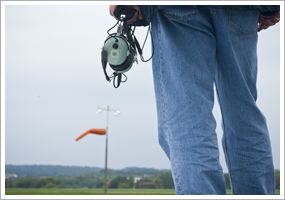| The following stories from the July 23, 2010, edition of AOPA ePilot were provided to AOPA members who expressed an interest in the particular subject areas. Any AOPA member can receive information tailored to their areas of interest by updating their preferences online. |
training tipsGone with the wind
Spare yourself the trouble! The simple truth is that all the prep in the world doesn’t predict everything that can happen. Experience breeds skepticism. Fortunately, that learning process starts with your first weather briefing.
One of the most common examples of feeling betrayed by the forecast is encountering surface winds that differ markedly from what was predicted. You soon learn that winds can change so quickly that even the wind speed and direction you get by radio when inbound for landing may not be what’s there when you arrive. In the July 2010 Flight Training story “ Phantom wind," one pilot recounted how that made a crosswind landing unnecessarily difficult. “The obvious had escaped me. The AWOS was wrong, or the conditions changed. There was no crosswind, and the airplane was clearly telling me so. With that detail, I landed easily,” wrote Joe Wilbur of the day’s unexpected lesson. Yes—of course you still should check the surface conditions being broadcast for your arrival. But how does one avoid the trap Wilbur describes? The Jan. 7, 2005, “ Training Tip: Check the sock” offers this tip: “When planning your arrival based on an ATIS broadcast, note the time it was prepared, stated at the beginning of the report.” Variable wind speed and direction are also clues.
All the more reason to heed the call by AOPA Air Safety Foundation President Bruce Landsberg to stay informed while helping others do likewise. “It is as important to report something that isn't there as what is. No turbulence, no ice, good visibility, etc. will help all of us make better decisions. If the forecast calls for bad weather and we can verify that it's safe to fly, that information should be widely distributed. When it is as bad or worse than forecast, it is vital for other pilots to know that the NWS nailed it,” he wrote in the safety article “ A trip not taken.” training productsDRE Communications DRE-1001Students looking for a low-cost headset have another option with DRE Communication’s newly upgraded DRE-1001. The company is known for producing quality, reasonably priced models, and the new DRE-1001 fits that mold. It features mil-spec parts, gel ears seals, and a steel headband for only $130.95.
Note: Products listed have not been evaluated by ePilot editors unless otherwise noted. AOPA assumes no responsibility for products or services listed or for claims or actions by manufacturers or vendors. final examQuestion: What kind of information can you gather by observing the windsock at an airport?
Answer: The windsock, or the “wind cone” as the FAA calls it, is a good source of information for a pilot. It not only indicates wind direction, but also allows the pilot to estimate wind velocity and gusts. According to FAA Advisory Circular 150/5345-27D “ Specification for wind cone assemblies,” a windsock will take the form of a truncated cone when filled with air. It must move freely and indicate the wind direction within 5 degrees in a 3-knot wind. The advisory circular also specifies that the cone will be fully extended in a wind of 15 knots. So, you may estimate that a limp windsock indicates a no-wind condition. A windsock extended at 45 degrees may indicate a wind of around 7 knots, and when the windsock is fully extended, the winds may be 15 knots or greater. Windsocks will tend to move back and forth when the wind is gusty. They point downwind, so when you land or take off, you will be flying from the smaller end of the cone toward the larger. For more information on windsocks or other wind indicators, take a look at “ Which way is the wind blowing?” in Flight Training magazine. Got a question for our technical services staff? E-mail [email protected] or call the Pilot Information Center, 800/872-2672. Don’t forget the online archive of “Final Exam” questions and answers, searchable by keyword or topic. |
 One of the truly perplexing situations for a new student pilot is coping with a “busted” forecast. The educational value of such a flight is incalculable, but too many students waste time berating themselves, and wondering whether they missed something that might have alerted them to the change.
One of the truly perplexing situations for a new student pilot is coping with a “busted” forecast. The educational value of such a flight is incalculable, but too many students waste time berating themselves, and wondering whether they missed something that might have alerted them to the change.

